Workplace Stress in the U.S. in 2025: Key Factors and Effective Solutions
Last Updated Nov 7, 2025

Workplace stress is fracturing the American workforce.
Nearly half of U.S. workers experience stress daily. Over 80% are at risk of burnout. And Gen Z is burning out 17 years earlier than the average American. That stress isn’t just staying at the office — it’s following people home, wrecking sleep, damaging health, and driving up turnover.
The impact shows up everywhere: lost productivity, skyrocketing healthcare costs, disengaged teams, and millions in avoidable expenses. From toxic culture to unrealistic workloads, the root causes are hiding in plain sight — and growing louder every year.
It’s time to stop normalizing exhaustion. Discover how to recognize, address, and reduce workplace stress before it drains your people — and your business.
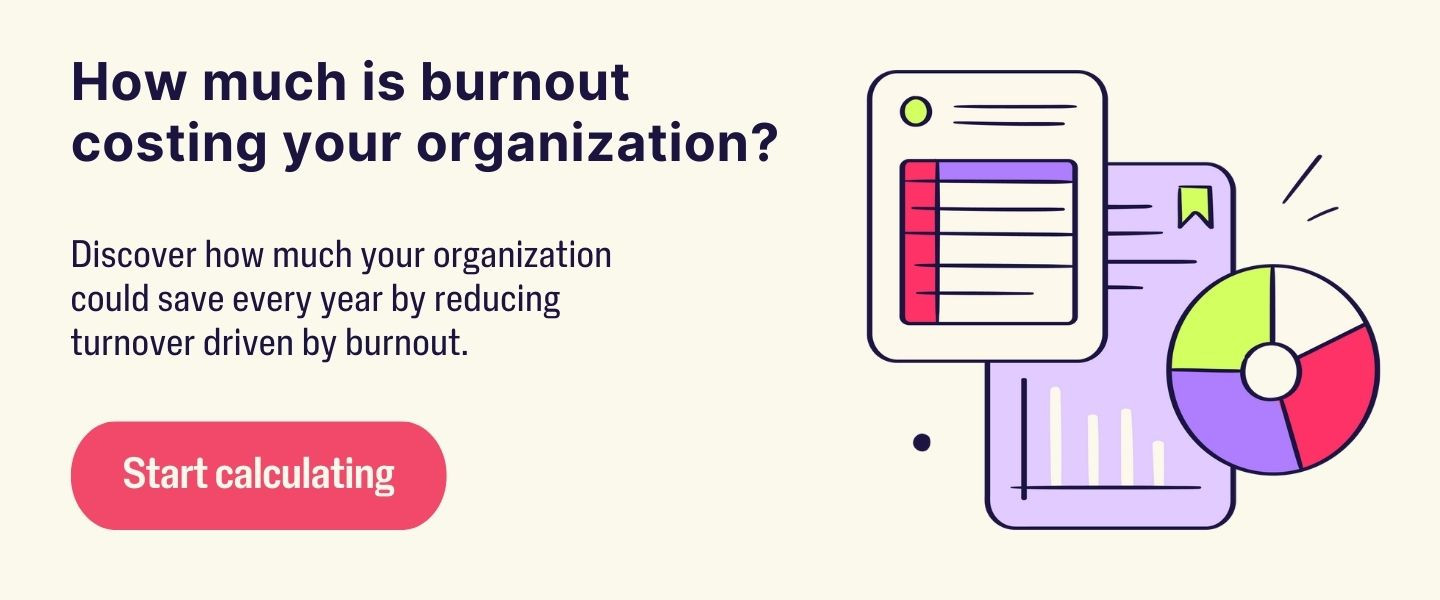
What You'll Learn
- The difference between healthy, short-term work pressure and harmful, chronic workplace stress — and why recovery time is the key factor.
- Leading causes of workplace stress in 2025, including excessive workloads, poor management, job insecurity, and lack of work-life boundaries.
- Alarming statistics on stress prevalence, burnout rates, economic costs, and its impact on productivity, health, and retention.
- Effective strategies organizations can use to reduce stress, from flexible scheduling and workload management to mental health and wellness programs.
- The legal and ethical responsibilities employers have to address workplace stress, and how proactive measures can improve both employee wellbeing and business outcomes.
What Is Workplace Stress?
Workplace stress is the physical, mental, or emotional strain that occurs when job demands exceed an employee's ability or resources to cope.
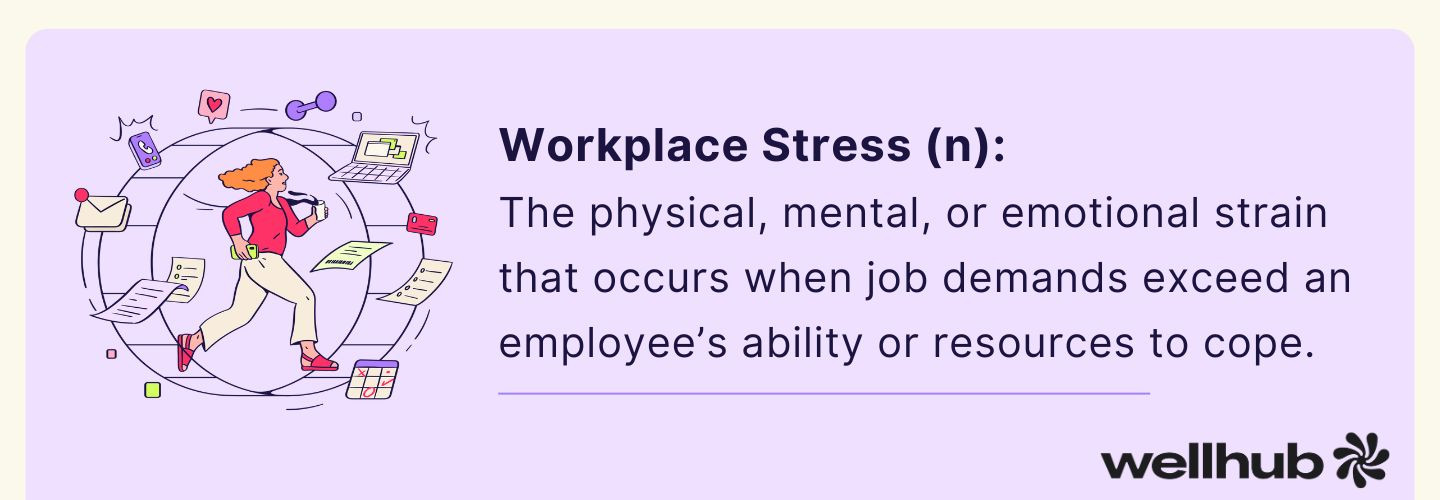
While everyone faces occasional pressure at work, there’s a clear difference between normal challenges that motivate you and chronic stress that makes you feel overwhelmed and anxious. Normal work pressure serves a purpose. It helps you focus when it’s time to deliver important projects and meet deadlines. This type of manageable stress is temporary and comes with a sense of accomplishment once you complete the task and have a chance to sit back and relax for a bit. Harmful workplace stress, however, becomes a constant presence that affects your physical and mental wellness.
The key difference is whether you get a chance to recover from stress. Healthy pressure lets you bounce back and feel energized after completing a difficult task. Chronic workplace stress follows you home, keeps you up at night, makes you feel guilty, impairs daily functioning, and creates a persistent feeling that you’re always behind or not good enough. If stress gets to this point, then something has to change.

How Workplace Stress Differs From General Stress
Workplace stress can be especially pernicious because it’s usually outside of your direct control. Personal stress might afford options for change, while work-related stress comes from organizational policies or management decisions that require organizational interventions.
The main causes of workplace stress are:
- Excessive workload: Having more responsibilities than can reasonably be completed within normal working hours
- Job insecurity: Uncertainty about employment stability due to company changes or economic factors
- Poor work-life wellness: Difficulty maintaining boundaries between professional and personal time
- Lack of autonomy: Limited control over how you complete tasks or make work-related decisions
Key Workplace Stress Statistics in the United States (2025)
Workplace stress affects far more people than most organizations realize, cutting across all industries and experience levels. That high-performing employee who always meets deadlines and overdelivers might be struggling with chronic stress. The cheerful colleague who volunteers for extra projects could be on the verge of burnout. These 2025 job stress statistics show just how common workplace stress is, and why it pays to make it a part of your conversations with leadership.
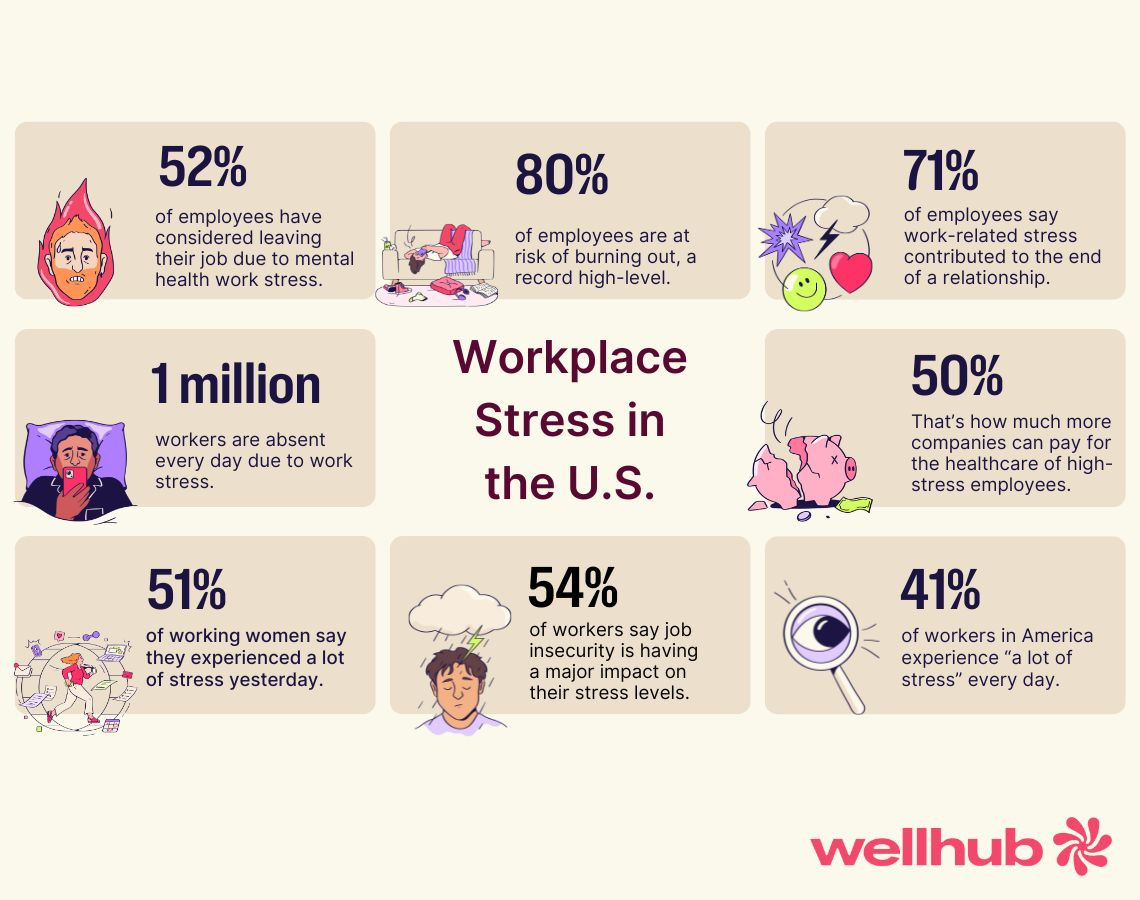
Prevalence
The numbers don’t lie when it comes to how common workplace stress has become in the U.S. Almost half of all American workers report experiencing work-related stress every single day, according to a Gallup study. That’s one in two people dealing with workplace stress every single time they come into the office.
But it’s even worse when you look at overall stress levels. Almost two-thirds of workers consider their job to be a very significant or significant source of stress in their lives, according to OSHA. When this many people are suffering from stress, signs point to more of a systemic issue.
Burnout
Burnout has reached crisis levels in American workplaces. Over 80% of employees are at risk of burnout in 2025, according to the Mercer Global Talent Trends report. This jaw-dropping percentage shows that burnout is now something anyone could succumb to.
The good news is that organizational leadership is aware of the risks of burnout. Around two-thirds of HR leaders across the country identified stress and burnout among their employees as the biggest workplace challenge. The priority now is to act on it.
Economic Cost
The financial impact of workplace stress isn’t something you’ll typically find on a balance sheet, but it can absolutely be felt. Just one burned-out employee costs an employer an average of around $4,000 per year through decreased engagement and reduced effectiveness, according to the American Journal of Preventive Medicine. Multiply this by over 80% of your entire organization, and that’s the potential overall yearly cost you’re looking at.
The figures are even scarier on a national scale. It’s estimated that burnout costs the U.S. economy approximately $300 billion per year, according to The American Institute of Stress. That’s a lot of wasted productivity that could contribute to rebuilding infrastructure, developing new technologies, or saving lives.
Workplace Stress by Age
Stress patterns across groups show perhaps surprising trends. You might think that more senior or executive-level workers with more responsibilities would reach peak stress sooner, but the numbers show the opposite. Gen Z and Millennial workers go through peak burnout at just 25 years old, which is 17 years earlier than the average American, who hits peak burnout at 42, according to a study from Talker Research.
This earlier onset of burnout suggests that there’s something wrong with how management is approaching the newer generations. What worked for Boomers and Gen Xers is no longer working for Millennials and Gen Zs, so organizations must adopt age-specific benefits that give people what they need to succeed.
Workplace Stress by Industry
Workplace stress manifests in many ways across different industries. A 2025 study found that arts, design, entertainment, sports, and media workers experience the highest rates of emotional distress at work, according to JAMA Network Open. Next in line were workers in healthcare, sales, food preparation, and food service, who also experience above-average levels of stress. These results show that it’s not always the stereotypically stressed-out lawyer or investment banker who needs help the most.
Workplace Stress by Job Type
The shift to remote work created interesting patterns in stress levels across different types of work arrangements. Remote workers experience significantly lower stress levels than in-person workers, according to a study published in the International Journal of Occupational Medicine and Environmental Health. This hints at the impact of commutes and office politics on a worker’s stress levels.
Trends in Workplace Stress Compared to Previous Years
Long-term research tracking stress levels since 1995 confirms that workplace stress continues to rise, although the rate of increase has been slowing down since 2015, according to the International Archives of Occupational and Environmental Health. Fortunately, recent years have seen a positive trend, as revealed in Wellhub’s State of Work-Life Wellness 2024report, which showed that 83% of workers felt their wellbeing improved in 2023 compared to 2022. That’s much higher than the 52% of workers who reported improvements in their wellbeing between 2021 and 2022.
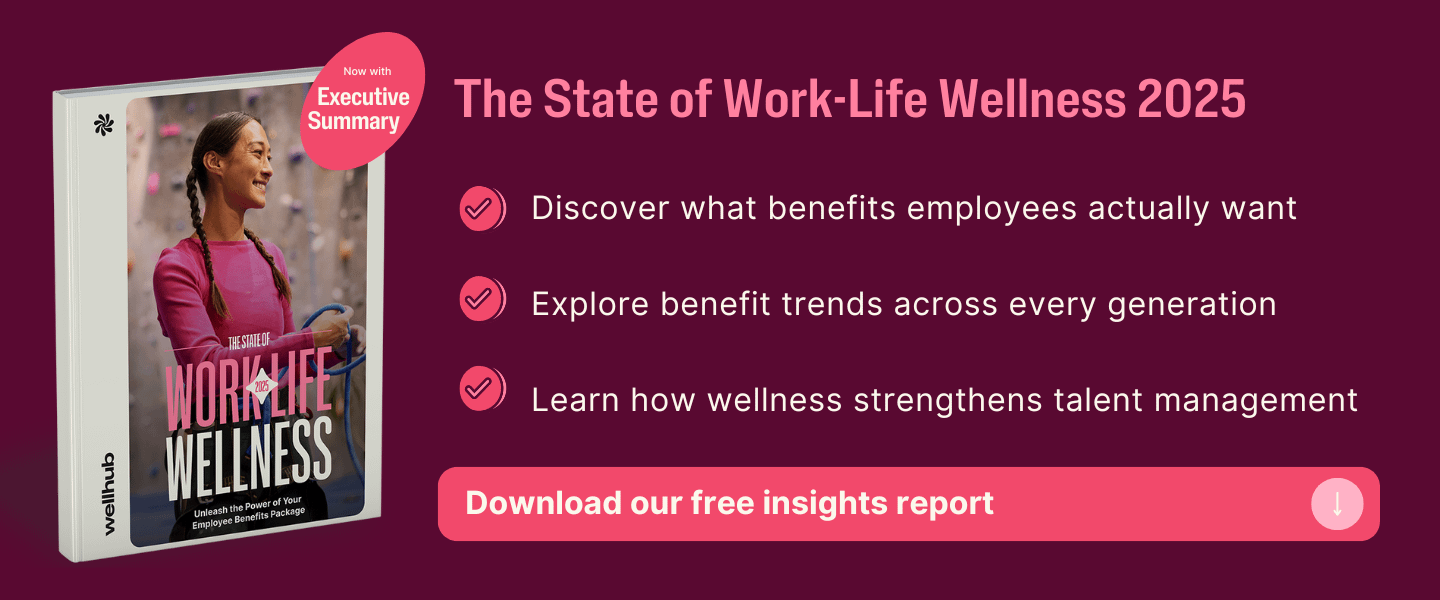
Common Causes of Workplace Stress in the United States in 2025
Workplace culture sets the tone for everything else. If leadership prioritizes employee wellbeing and creates supportive environments, then even challenging work can be manageable. If the culture is toxic and disrespectful, then even simple tasks feel overwhelming. The day-to-day interactions and management approaches in your workplace will reveal if employees are thriving or barely surviving.
The numbers show this clearly. About one in five employees in the U.S. describe their workplace as toxic, according to the American Psychological Association. That means people dread going into work because of the environment itself, not the job responsibilities. These are the biggest workplace stressors in 2025:
- Poor management and leadership: Getting conflicting instructions from different managers puts you in an impossible spot where someone always thinks you’re doing it wrong. Micromanagers who question every decision will make you anxious about everything you do.
- Excessiveworkload and unrealistic expectations: Having more work than any human could reasonably finish creates a sinking feeling where you’re always behind. No matter how many hours you put in or how efficiently you work, the pile never gets smaller.
- Job insecurity and lack of growth opportunities: Worrying about layoffs or seeing no path forward in your career creates a different kind of stress that follows you everywhere. It’s hard to feel motivated when you’re not sure if your job will exist next month.
- Financial stress: Almost half of Americans consider 2024 the most financially stressful year of their lives, according to MarketWatch research. Many people struggle to pay the bills despite having jobs, and financial wellness requires more than just a paycheck. Companies that offer solid benefits like 401(k) matching and access to budgeting tools help people feel safer in their financial situation.
Want to tackle stress at its source?Find out what causes workplace stress and how to manage it.
The Negative Business Consequences of Work-Related Stress on American Workers in 2025 (In Numbers)
Workplace stress creates a domino effect that can be felt across the organization. If a worker is struggling with chronic stress, their work performance drops, and their ability to contribute to the company diminishes tremendously. What starts as personal stress becomes a business problem that affects productivity and company culture.
Decreased Employee Productivity
Hustling all the time isn’t good for stress levels or productivity, no matter how much you try to force yourself to work. In an experiment, employees were forced to take regular breaks instead of powering through the workday, and they found that productivity increased by 21% and employees’ abilities to manage stress increased by 230%, according to a 2024 Slack study.
Increased Fatalities and Chronic Illness
Chronic workplace stress isn’t just hurting productivity—it’s literally shortening lives. Chronic job stress contributes to around 120,000 deaths each year in the United States, primarily driven by cardiovascular disease, burnout, and decline in mental health. Behind every number is a lost employee, family member, and community contributor.
Spike in Mental Health Claims and Lost Workdays
The toll on mental health is reaching new heights. In 2025, nearly 85% of workers reported experiencing burnout or exhaustion, and 47% were forced to take time off for mental health issues. The result? About 1 million workers are absent on any given day because of stress-related complications—a figure that translates into staggering lost productivity.
Healthcare Costs and Legal Exposure
Stress-related health issues are inflating company healthcare costs toward the breaking point. In 2025, stress-related healthcare expenses alone totaled $190 billion, with direct legal and insurance costs continuing to tick upward as workers take more time off and file more claims related to workplace mental health and burnout. Employers face unprecedented insurance premium hikes and exposure to workplace injury litigation involving stress and mental health.
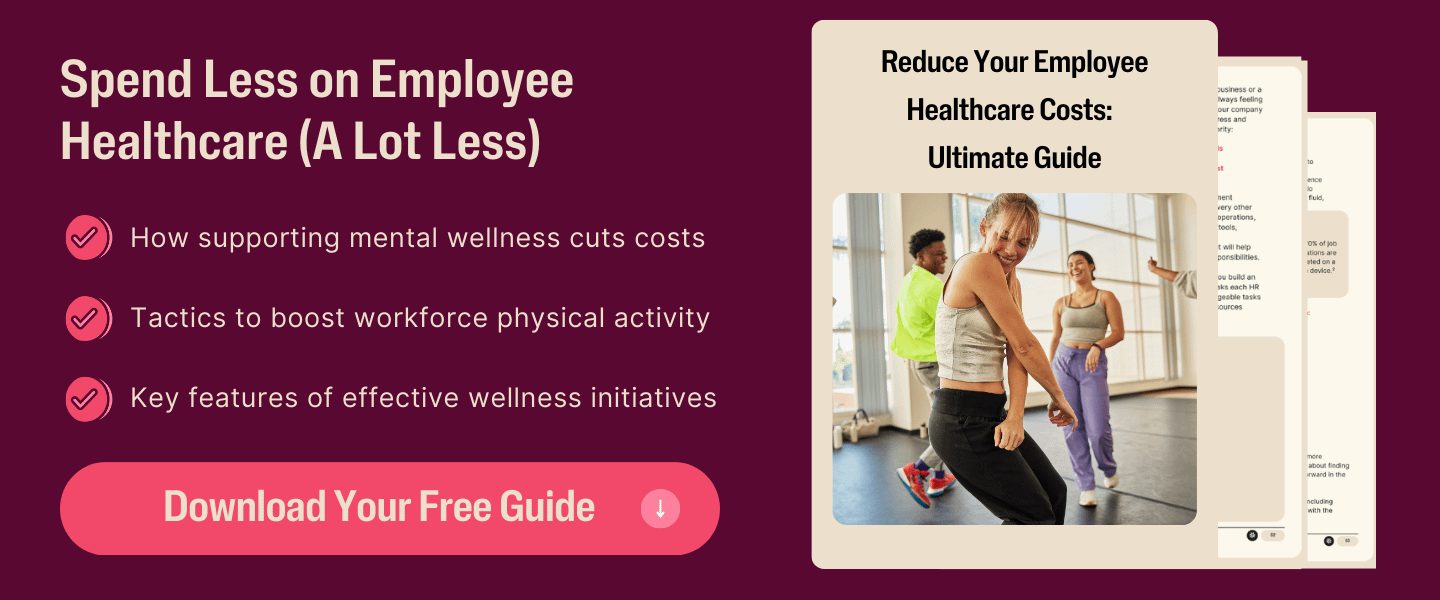
Turnover and Talent Drain
Stress doesn’t just lead to absenteeism—it drives workers straight to the exit. Workplace stress is responsible for 40% of employee turnover in the U.S., with younger workers (Gen Z and Millennials) especially likely to consider switching jobs to escape physically and emotionally draining environments. This leads to steep replacement costs; companies lose between $4,000 and $21,000 per employee replaced due to burnout, with small firms (1,000 employees) losing around $5 million annually just from turnover and burnout.
Impact on Team Collaboration and Engagement
The ripple effect of stress can poison collaboration and culture. In 2025, 52% of employees experiencing high stress report feeling disconnected from colleagues and their work, leading to reduced engagement, lower morale, and fractured teams. These “quiet quitters” can have just as much impact as someone who leaves entirely.
Job Insecurity and Its Domino Effect
As organizations face constant economic and policy changes, 54% of U.S. workers now say job insecurity has a significant impact on their stress levels. This insecurity fuels anxiety, undermines confidence, and drives workers to disengage or even prematurely exit roles—further accelerating turnover and organizational instability.
Emotional Exhaustion and Quality Decline
Workplace stress is robbing American businesses of quality as well as quantity. Nine out of 10 employees report that overwhelming stress negatively affects their work quality, with 41% saying it directly reduces their productivity and 33% admitting it undermines engagement and motivation. Even when present, stressed workers struggle to deliver
The bottom line: workplace stress is no longer just an HR problem—it’s a business survival challenge. Every leader must make stress reduction core to their strategy if they want to keep employees healthy, productive, and committed. The numbers don’t lie, and the future of American business depends on how organizations choose to respond.
Identifying Signs of Stress in the American Workplace
Finding who among your team is stressed out is about looking for small changes instead of a dramatic breakdown in the break room. Your usually punctual team member might start showing up a little late, or the colleague who used to be very chatty is now very reserved.
Some employees wear their stress openly, but others hide it behind perfectionism or overworking. Look out for these five signs of stress in the workplace:
- Working late all the time: If someone starts staying until 10:00 PM every night, it might mean that they feel so behind that they see no other way out. Almost two-thirds of HR leaders reported working beyond their normal capacity, according to SHRM research.
- Getting sick constantly: That person who always seems to have a cold or feels run down might be dealing with more than bad luck. Chronic stress increases cortisol levels and weakens the immune system, according to the Journal of Clinical Medicine.
- Withdrawing from colleagues: The team member who used to join lunch conversations but now eats alone at their desk might be going through something.
- Becoming extremely irritable: If a minor problem triggers an outsized reaction, it’s usually a sign of something else.
- Declining work quality: Missed deadlines or sloppy work from people who used to be extremely reliable might be a sign that stress is affecting their ability to focus.
Effective Strategies To Reduce Workplace Stress
Effectively addressing how to lower stress at work requires more than just a pizza party, no matter how delicious the pie. To fix it, your organization will have to tackle the root causes of stress instead of just trying to find temporary solutions to keep everyone running on fumes.
A healthy workplace culture can lead to higher work engagement levels and lower stress, according to a 6,000-person study from the International Journal of Environmental Research and Public Health. Build a solid culture, and employees will stay healthy and committed.
Workload Management and Flexible Scheduling
No one thrives under a mountain of impossible deadlines. Yet unrealistic expectations are one of the most common and most fixable drivers of workplace stress. Instead of assuming “busy” equals “productive,” it’s time to shift toward smart workload management.
Managers should regularly review what their teams are being asked to do — and whether they actually have the capacity to do it. When they don’t, stress rises and performance drops. That’s why a proactive check-in on bandwidth and clarity of responsibilities can be so impactful.
Flexible scheduling can also go a long way in reducing stress. Letting employees start later, finish earlier, or choose their own hours gives them the ability to shape their workday in a way that works for their life. This doesn’t mean working less — it means working smarter.
And here’s the key: employees who feel psychologically supported at work are significantly less likely to experience burnout. Creating that support starts with adjusting the pressures we place on people — and giving them the flexibility to manage how and when they meet expectations.
Supporting Work-Life Wellness with Wellness Programs
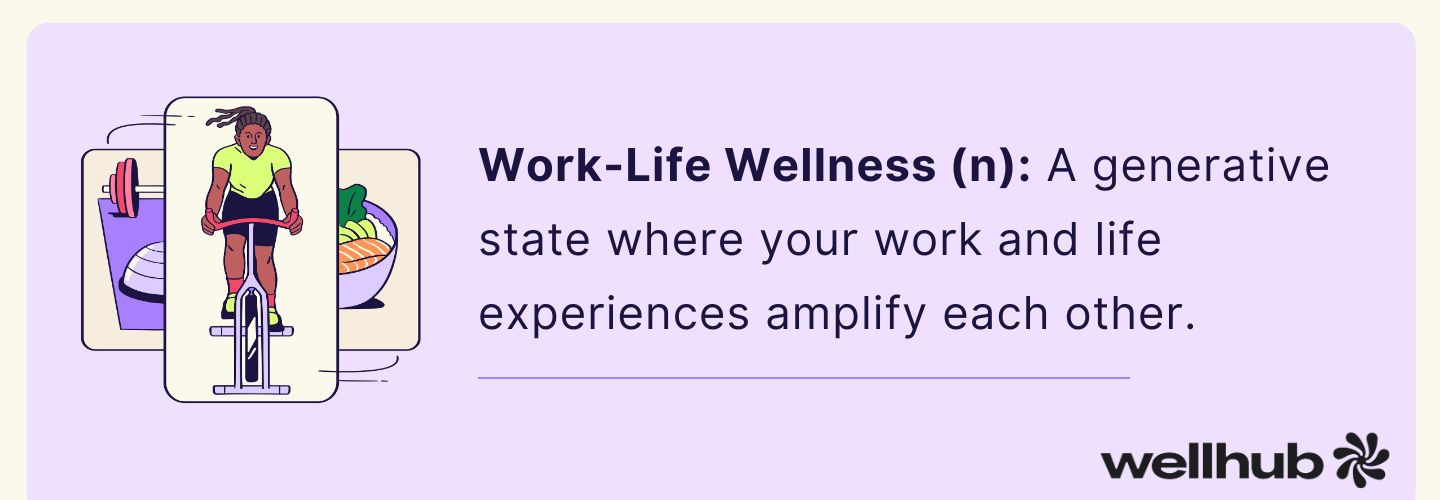
“Work-life wellness” isn’t just a buzzword — it’s a business-critical priority: Exercising even just once a week was shown to reduce a worker’s stress levels substantially, according to a study published by ProQuest.
But you can’t rely on good vibes and reminders to “log off.” To lower stress in a meaningful way, work-life wellness must be baked into policies, not just culture.
Start with clear boundaries around communication. Create norms where after-hours emails are the exception, not the rule. Train managers to respect PTO — not just approve it — and to model healthy work habits themselves.
Physical wellness also plays a major role in mental resilience. But employees don’t always have time to prioritize it. According to Wellhub’s State of Work-Life Wellness 2025 report, 56% of workers say time constraints are the biggest blocker to staying active. That’s a huge opportunity to step in and help.
Offer wellness stipends, on-site classes, or just dedicated movement breaks during the workday. Even a single workout per week has been shown to substantially reduce employee stress levels. It’s not about forcing fitness — it’s about making space for wellbeing.
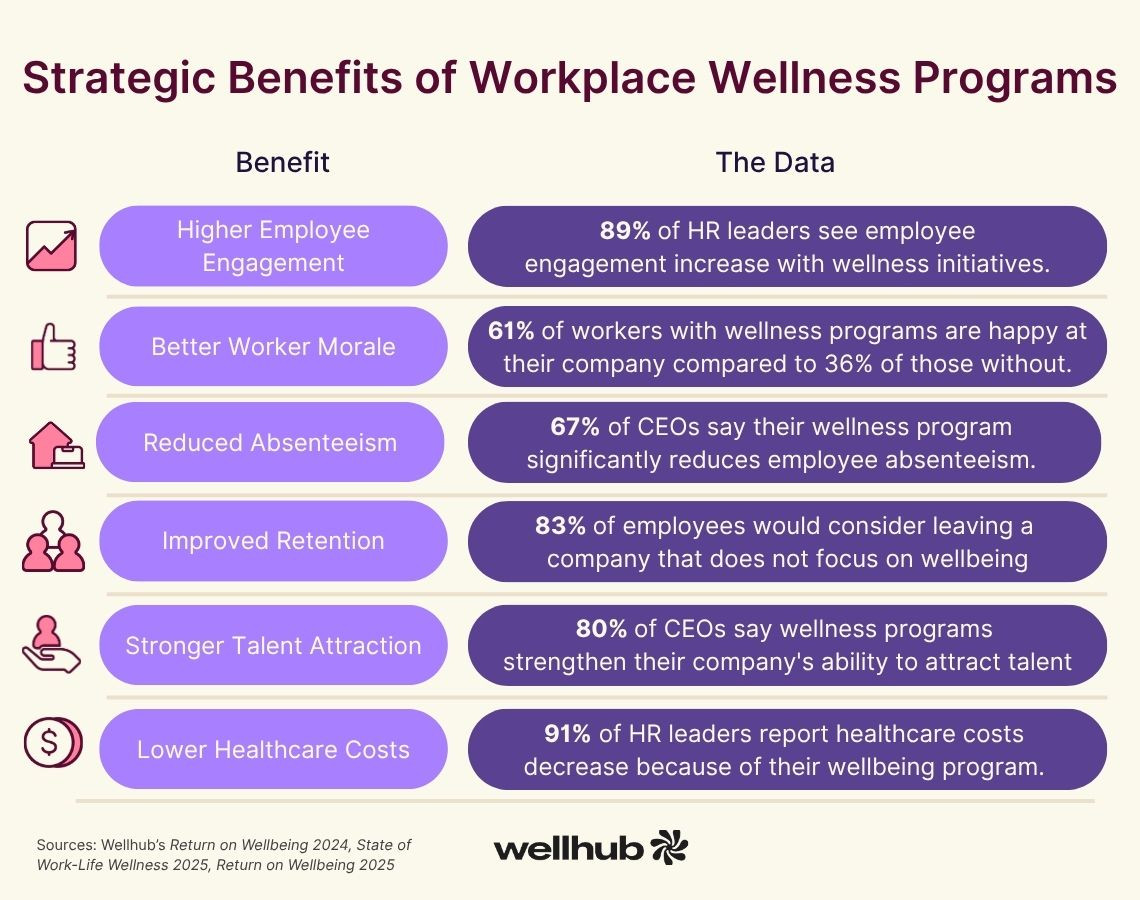
Creating a Culture That Supports Mental Wellbeing
Mental health isn’t a side conversation anymore—it’s central to how your employees feel, function, and perform. Right now, 47% of employees say work stress is degrading their mental wellbeing, making it the leading cause of emotional health issues in the workforce.
If you want to lower stress, create a psychologically safe environment where employees are encouraged to talk about mental health, access care, and take time to recharge. Start with:
- Manager training: Equip people leaders to spot the signs of burnout and respond compassionately.
- Normalizing therapy: Offer counseling benefits and talk openly about them—because over half of employees say therapy is extremely important to their wellbeing, but only 37% are currently in therapy. Why? For 36%, cost is the main barrier.
- Clear boundaries: Encourage time off, set email expectations, and lead by example.
Companies that embed mental health into their culture see real returns. For example, 59% of employees with wellness programs say their mental wellness improved over the last year, compared to just 36% of workers without one. That’s not just a win for employees—it’s a boost to retention, engagement, and morale.
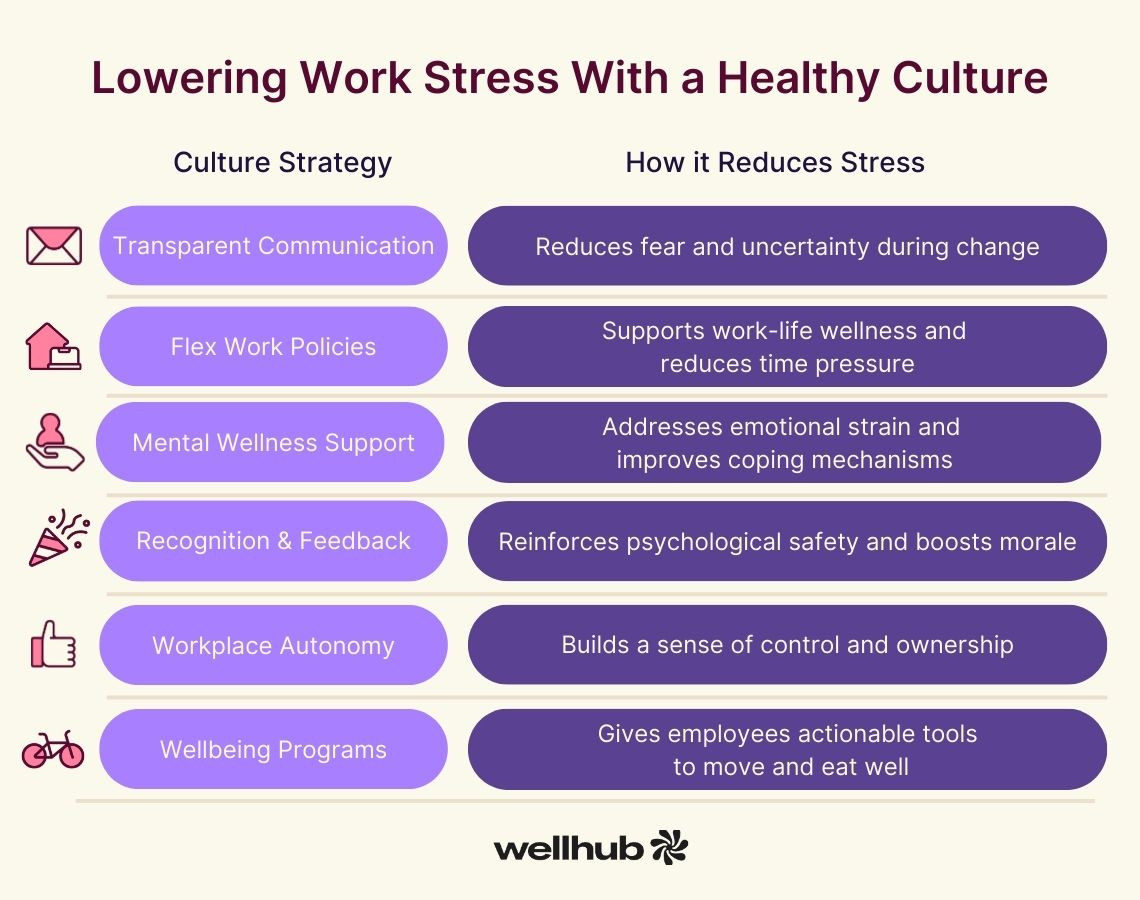
Providing Access to Physical Activity During the Workday
You don’t need to run a fitness bootcamp in the break room — but you do need to remove the barriers that make movement feel out of reach.
Time is the top blocker for workers who want to be more active. In fact, 56% of employees say lack of time keeps them from exercising regularly. That means one of the most effective strategies to lower stress is also one of the simplest: give people time and space to move.
Here are a few easy ways to do that:
- Offer walking meetings or breakroom yoga
- Provide access to on-demand or in-person fitness classes
- Create no-meeting hours in the afternoon to encourage movement breaks
When employees move more, they feel better. It’s that simple. And feeling better physically helps them manage stress mentally.
Offering Nutrition and Sleep Support
Stress doesn’t live in isolation — it impacts sleep, eating habits, and energy levels. Over half of workers say stress and anxiety are causing them to lose sleep. And cost is a top reason why employees say they can’t maintain a healthy diet.
That’s a serious wellness problem with a business impact. Sleep-deprived, undernourished teams don’t bring their best selves to work.
You can help by:
- Offering nutrition counseling through wellness benefits
- Promoting hydration and healthy snack options at work
- Educating employees on sleep hygiene and stress reduction
Small interventions can have big effects. When employees sleep better and eat well, their ability to manage stress improves — and so does their overall productivity.

Legal and Ethical Considerations Around Workplace Stress in the United States (2025)
Supporting employee mental health and addressing workplace stress is about more than employer branding: a legal and ethical imperative for U.S. employers. For HR leaders, managing risk and protecting both employees and the organization requires close attention to evolving standards and best practices.
Legal Responsibilities
Employers are required under OSHA’s General Duty Clause to provide a workplace free from recognized hazards, which includes harmful stress levels. While there isn’t a dedicated federal standard for workplace mental health, OSHA can cite employers for failing to mitigate job-related risks that result in serious harm or death. Following OSHA’s mental health guidance, published in 2024, is strongly recommended—even if not strictly mandatory—to avoid liability if a claim arises.
Stress-related claims may trigger workers’ compensation cases, especially when mental health impacts job performance or leads to injury. Federal statutes such as the Americans with Disabilities Act (ADA) and Family and Medical Leave Act (FMLA) can also require employers to provide reasonable accommodations for stress-related disabilities or allow protected leave. Ignoring or dismissing employee mental health disclosures can lead to costly legal battles.
State laws and city ordinances increasingly address paid sick leave, mental health, and safe workplace requirements. Examples include new paid leave laws in cities such as Chicago as of July 2024. Employers must stay current with local updates to remain compliant across jurisdictions.
Stress is costing companies more than ever. Find out how to stop it before it harms performance.
Ethical Imperatives
Ethically, organizations have a duty of care that encompasses the physical and psychological safety of employees. This means proactively identifying stressors—like excessive workloads, lack of support, unclear roles, or workplace bullying—and taking steps to mitigate them. Early interventions such as stress audits, surveys, and confidential reporting channels help demonstrate good faith and build trust.
A truly healthy workplace prioritizes inclusive policies, ensuring employees feel safe to speak openly about mental health without stigma or career risk. Leadership should model transparency and support, encouraging employees to seek help, use Employee Assistance Programs, and access flexible working arrangements when needed.
Making reasonable accommodations—like reduced workloads or flexible hours—for people facing stress-related health challenges is both an ethical responsibility and, in many cases, a legal requirement. Employee well-being programs, manager training, and open communication are key pillars for prevention and support, and evidence-based organizational investments are crucial for long-term success.
Ethical employers document risk assessments, stress management efforts, and accommodations. This helps defend against claims and demonstrates genuine commitment to employee wellness.
Practical Steps for HR Leaders
- Conduct regular workplace stress audits and surveys.
- Develop clear stress management and anti-bullying policies.
- Train managers to recognize and respond to signs of stress.
- Provide confidential mental health support and assistance.
- Ensure compliance with OSHA, ADA, FMLA, and shifting state laws.
- Document actions and regularly review legal developments.
HR leaders who stay ahead of legal shifts and embed ethical care into culture help create workplaces that attract, retain, and empower top talent, while minimizing risk and elevating organizational performance
How Investing in Stress Reduction Benefits Business Outcomes
Stress is personal — but its impact shows up all over the organization. When you reduce stress, you’re not just supporting employee wellbeing. You’re fueling productivity, engagement, and retention. And those are bottom-line business metrics.
Let’s start with the big picture, captured by Wellhub's Return on Wellbeing 2025: The CEO Edition: 73% of CEOs say their wellbeing programs improve talent retention, and 97% say those programs enhance productivity. That’s a major signal from the top that wellness isn’t just “nice to have.” It’s strategic.
Here’s where you’ll see results:
- Lower absenteeism: Two-thirds of CEOs say their wellness program reduces employee absenteeism.
- Better talent acquisition: Eighty percent say their wellness programs help attract top talent — and 42% call it “extremely impactful”.
- Higher ROI: Eighty-two of CEOs report a positive return on their wellness investment, with 30% seeing a return of $2 or more for every $1 spent.
And employees feel it too. In companies with wellness programs, 59% say their mental health improved last year. Compare that to just 36% of workers without a wellness program. That’s not a coincidence. It’s the result of intentional investment.
For CHROs looking to boost performance and reduce costs, this is one of the clearest, most actionable levers to pull.
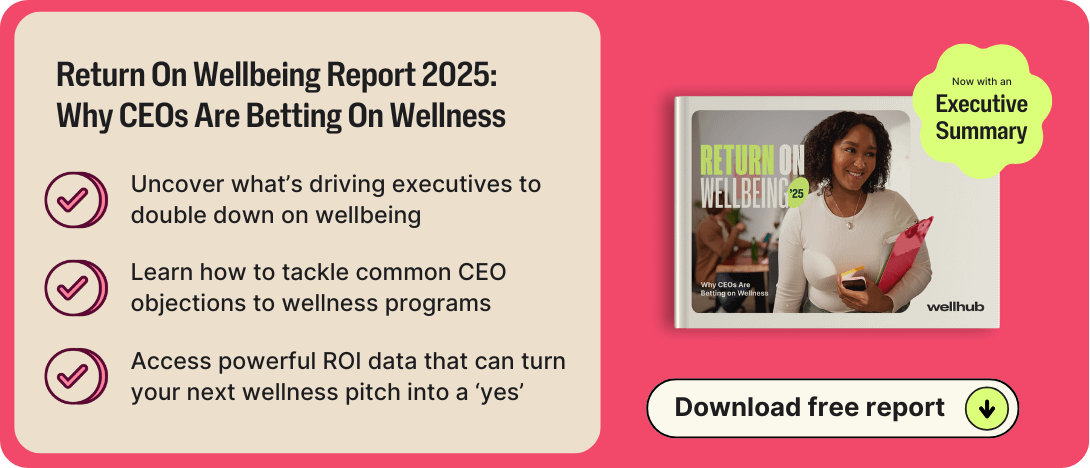
Steps To Build a Sustainable Stress Management Plan
To create a stress management plan that works long term, you’ll need more than good intentions and a one-time wellness seminar. To create a sustainable stress management program, start by understanding the specific pain points in your workplace and then build systematic approaches that employees can rely on.
Follow these steps to create an effective stress management plan in your workplace:
- Measure current stress levels: Survey employees to understand what’s causing stress.
- Identify root causes: Look beyond surface symptoms to find the organizational factors that create stress.
- Set your goals: Choose specific, measurable targets (SMART goals) like reducing stress in survey results by 20% before the end of the year.
- Implement evidence-based solutions: Choose interventions that are backed by research instead of trendy programs with no scientific evidence to support them.
- Measure the impact of stress reduction efforts: Track metrics like engagement scores, turnover rates, sick days, healthcare costs, and stress leave days to evaluate if your efforts are working.
- Adjust and improve over time: Use your measurement data to refine programs and replace ineffective ones with better approaches.
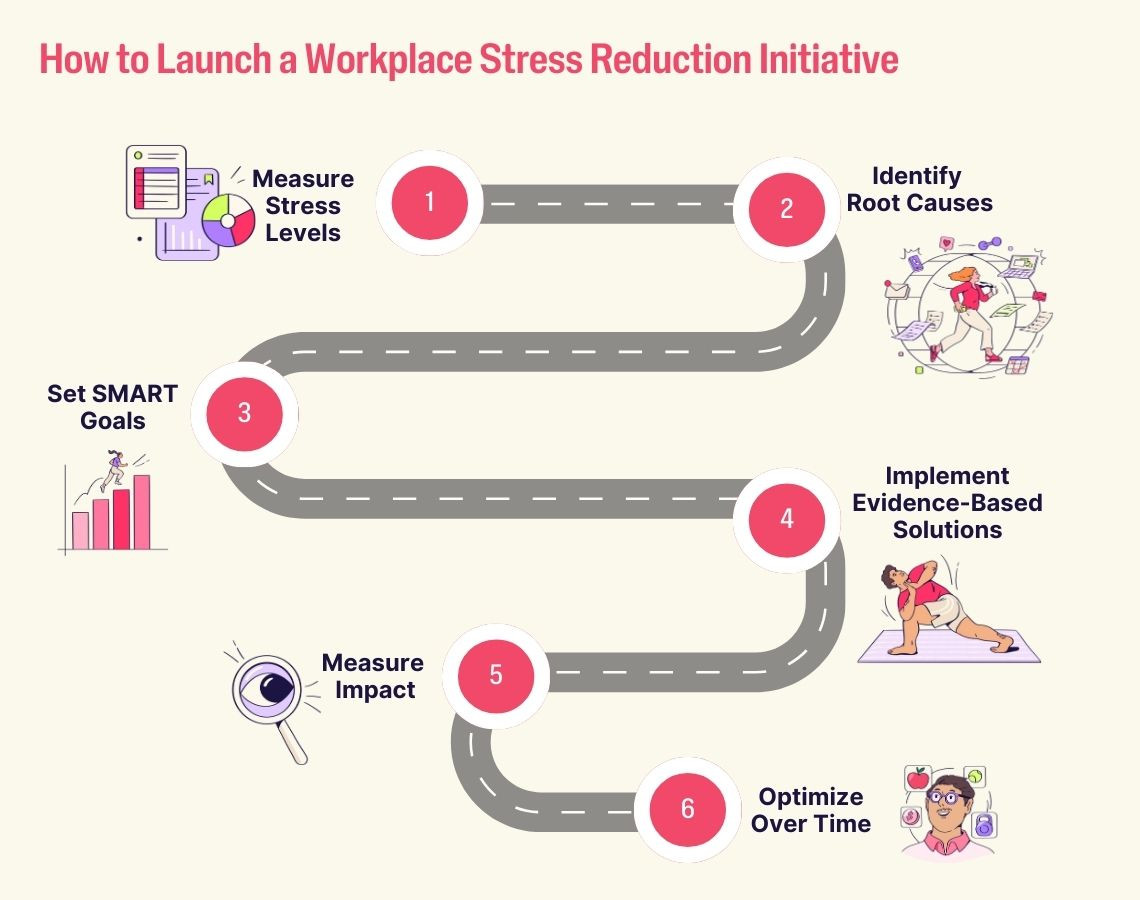
Work-Related Stress FAQs
What Are the Statistics of Workplace Stress?
Almost half of American workers deal with work stress every day, and two-thirds consider their job to be a significant source of stress. Over 80% of employees are at risk of experiencing burnout in 2025, while stress costs the U.S. economy around $300 billion per year.
Do 83% of US Workers Suffer From Work-Related Stress?
Wellhub’s State of Work-Life Wellness 2024 report found that 83% of workers report losing sleep over work stress. This indicates that over 80% of workers report dealing with unhealthy levels of work stress.
What Percentage of Americans Feel Stressed at Work?
About 49% of American workers experience work stress every single day, but almost two-thirds of them consider their job to be a big source of stress in general.
How Much Stress Is Normal at Work?
Some workplace stress is normal and can help improve performance when dealing with tough projects or tight deadlines. Stress becomes a problem when it’s constant, makes you lose sleep, affects your personal life, or makes you feel overwhelmed most days.
Reduce Workplace Stress with Wellhub
Reducing stress starts with removing barriers — to movement, mental health, rest, and recovery. That’s exactly where Wellhub comes in.
Wellhub gives your employees access to thousands of wellness partners across fitness, therapy, nutrition, and mindfulness. Whether someone wants to take a yoga class at noon, meditate before a big meeting, or talk to a licensed therapist on their lunch break, they can find what they need, when they need it — all in one place.
That kind of choice matters. Nearly 80% of employees who have access to a wellness program use it. And when they do, the results are significant:
- 61% of employees with wellness programs say they’re happy at work, compared to just 36% without one
- They sleep better (39% vs. 21%)
- They feel more mentally well (59% vs. 36%)
- They eat better (47% vs. 29%)
All of that adds up to lower stress and better performance.
And for HR leaders like you? Wellhub makes it easy to manage, track, and report on program engagement and outcomes. That means you can not only support your people — you can prove the impact of that support across the business.
Want to learn how Wellhub can reduce stress at your workplace? Talk to a wellbeing specialist today.

Company healthcare costs drop by up to 35% with Wellhub*
See how we can help you reduce your healthcare spending.
[*] Based on proprietary research comparing healthcare costs of active Wellhub users to non-users.
Category
Share

The Wellhub Editorial Team empowers HR leaders to support worker wellbeing. Our original research, trend analyses, and helpful how-tos provide the tools they need to improve workforce wellness in today's fast-shifting professional landscape.
Subscribe
Our weekly newsletter is your source of education and inspiration to help you create a corporate wellness program that actually matters.
Subscribe
Our weekly newsletter is your source of education and inspiration to help you create a corporate wellness program that actually matters.
You May Also Like

FSA vs. HSA Strategy for HR Leaders | Wellhub
Compare FSA vs HSA rules, tax advantages, eligibility, and rollover differences to help employees choose the right account and avoid costly compliance issues.

Employee Wellness Programs: Key Components for Success | Wellhub
Transform your workplace wellness strategy by integrating physical, mental, financial, and social wellbeing into a comprehensive wellness program that works

Benefits Strategy Roadmap: Pull and Retain Top Talent | Wellhub
Support wellbeing, reduce turnover, and maximize ROI with a benefits strategy built for today’s workforce—not yesterday’s spreadsheet.